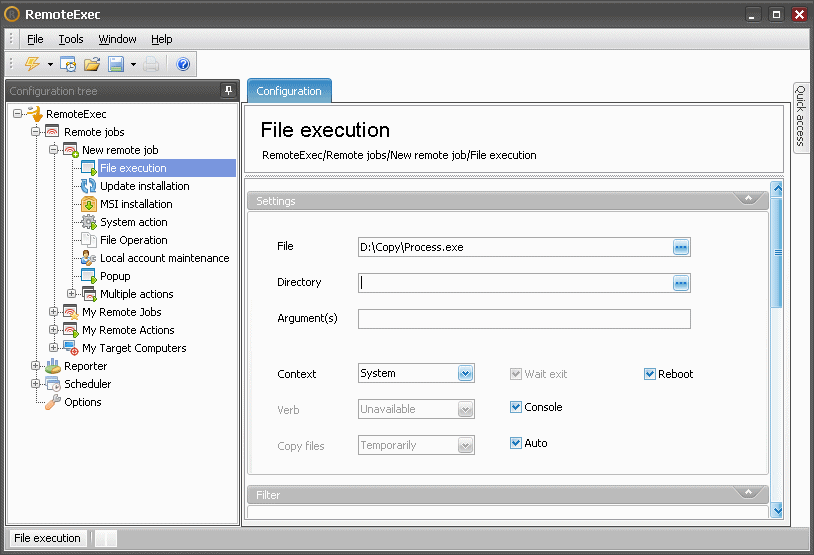
This is the most generic Remote Action allowing to remotely execute any executable file.
File: Path
of the file to run.
The file can be a standard executable (e.g.: *.exe, *.bat, *.cmd, *.vbs,
*.js) or any file associated to an executable (e.g. : *.txt, *.wav, *.reg,
*.inf ....)
Directory: Working folder for the executable. Warning! If the Copy files option is checked the whole folder will be then copied on all Target Computers.
Argument(s): Arguments for the executable file.
Verb: Type of execution. For example a .txt file verb can be Open or Print. In most cases you must use the Open verb. In Auto mode a verb is automatically selected for optimal remote execution.
Auto: When you check this, the best options are automatically selected for optimal remote execution for most known file types according to some optimization rules.
Context:
You can execute your remote process under five security contexts.
- Interactive: When you select this, the file is executed using
the environment of the user currently logged on the remote computer. The
user can see the execution and interact with the program. The execution
will fail if no user is logged on the remote computer.
- Administrative:
The process is started under the account running RemoteExec
(your account) but with downgraded rights. The running process will then
have no right on the network (i.e.: no access to remote shared folders).
Nothing will be displayed on the remote machine screen. This option is
automatically selected as needed in Auto
mode.
- Full administrative: The process
is started under your current account with full rights. You need to enter
your password. Using this execution context is slower than the Administrative
context but very useful for deployment tasks of package located on shares.
- System: The remote process is
started with the localsystem
account.
- Interactive system: Same as
previous but in addition the process has access to the user desktop. You
can use this mode to start an installation package without any silent
installation mode available and so permit a user without administration
rights on its computer to complete the installation wizard.
Warning! This execution context can be considered as a security
leak as the logged on user has temporary administrative rights on the
computer. Use it only if there is no other way.
Wait exit: RemoteExec will wait for the launched process to be exited before completing the RemoteExec operation. You can kill any hanged process in the Progress Window by clicking on the Kill button. This option is automatically selected as needed in Auto mode.
Console: Check this box if you want to see
locally the command line console in order to view the execution of the
program (only for console programs and scripts). You can event interact
remotely with the program like a telnet. The output of the console is
automatically saved in the database.
Warning! Graphic applications cannot be launched with this option.
Copy files:
- No: To use when the file is
on a share or when the file is already available at the same location
on the remote computer.
- Temporary: The files and the
working folder are copied in a temporary folder on the remote computer
(c:\winnt\temp\{GUID}). The Wait exit
option has to be selected in order to automatically delete this folder
after the process exited. This option is automatically selected as needed
in Auto mode.
- Permanently: The files and the
working folder are copied permanently on the remote computer (in the same
location as specified in the Action
path).
